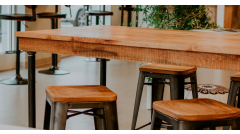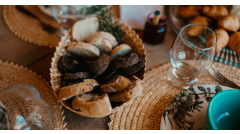Welcome to your ultimate guide on keeping your Camp Chef Camp Table in pristine condition! Whether you’re gearing up for your next outdoor adventure or simply enjoying a weekend at the park, this table is designed to elevate your camping experience with its functionality and durability. Maintaining it properly means more enjoyable meals, better organization, and countless memories made around the fire.
In this guide, we’ll walk you through essential cleaning and maintenance tips to ensure that your Camp Chef Camp Table serves you well for years to come. Get ready to learn the best practices for keeping this camp essential in top shape, so you can focus on what really matters—enjoying the great outdoors!
The Camp Chef Camp Table is a versatile and portable solution for outdoor cooking and meal preparation. Measuring 32 inches, it provides ample space for Dutch ovens and additional prep work, making it an ideal companion for camping trips, picnics, or backyard gatherings. This sturdy table features sturdy legs for stability, ensuring it can withstand the rigors of outdoor use while offering a reliable surface for all your culinary activities. Enjoy the convenience of having a dedicated space for cooking that enhances your outdoor dining experience.
Cleaning Essentials
Maintaining the cleanliness of your Camp Chef Camp Table is crucial to ensure its longevity and functionality during your outdoor adventures. To start, gather the following cleaning supplies, which will help you effectively clean and care for your camp table:
- Mild liquid soap: Choose a biodegradable soap that is safe for outdoor use.
- Soft sponge or cloth: A non-abrasive sponge or microfiber cloth will prevent scratches and damage to the table's surface.
- Warm water: This will help to dissolve dirt and grime effectively.
- Non-abrasive cleaner (optional): If your table has any stubborn spots, a gentle cleaner specifically designed for the material can be helpful.
- Paper towels or an additional cloth: For drying after cleaning.
- Soft brush (if needed): To reach nooks and crannies on the legs or corners.
Before diving into the cleaning process, ensure you have all these items within arm's reach. A designated cleanup area will streamline your efforts. Consider laying down a tarp or using a nearby picnic table to keep your supplies organized, preventing any dirt particles from contaminating your equipment. This preparation allows you to focus solely on cleaning your Camp Chef Camp Table without any interruptions.
- Check that your sponge and cloths are clean before use to avoid transferring any debris back onto the table.
- Organize your cleaning solution and tools in a way that makes it easy to grab them as needed.
Disassembly Process
Disassembling your Camp Chef Camp Table is essential for ensuring proper cleaning and maintenance, especially after a fun and messy camping trip. Begin by preparing your workspace to make the process as smooth as possible. Clear the area of any obstacles and have a clean cloth or rag handy in case you encounter any dirt or debris during disassembly. Now, let’s go through the steps to safely remove the legs, surfaces, and attachments without causing any damage.
Start by flipping the table upside down on a soft surface like a mat or blanket to avoid scratching the table top. Locate the locking mechanisms for the legs; typically, these will be a simple latch or pin system. Follow these steps:
- Using your fingers or a flathead screwdriver, release the locking mechanism to free the legs from the table base.
- Gently pull each leg away from the base. Ensure you're not yanking too hard, as this could cause wear on the attachment points.
- Grasp the leg firmly at the base while turning it slightly to release any remaining tension in the locking mechanism.
- Once all legs are removed, set them aside in a safe location to avoid tripping hazards.
- Next, take a look at the tabletop. If it has any removable attachments, such as clips or brackets for holding additional gear, carefully release these as well by following the same technique you used for the legs.
After ensuring all components are separated, you can now clean each part thoroughly. To reassemble, simply reverse these steps, taking care to securely lock everything back in its place, ensuring your Camp Chef Camp Table remains sturdy and ready for your next outdoor adventure.
- Always check for any debris in the locking mechanisms before reassembling.
- If possible, check manufacturer guidelines for any specific cleaning solutions that should be used.
Surface Cleaning Steps
Cleaning the surface of your Camp Chef Camp Table is essential to maintain its integrity and usability, especially after a fun day of cooking outdoors. Start by gathering your supplies, including a soft cloth or sponge, mild dish soap, warm water, and a sanitizing solution, such as a food-safe sanitizer. This preparation ensures that you have everything at hand to tackle dirt, grease, and any food residue effectively.
Begin the cleaning process by thoroughly wiping down the surface with a soft cloth or sponge that has been dampened with warm water and a few drops of mild dish soap. Avoid using abrasive scrubbers, as they can scratch the surface finish. Instead, use gentle circular motions to lift dirt and grease. For stubborn spots or food residue, allow the soapy solution to sit for a few minutes before wiping it away. After removing visible residues, rinse the cloth or sponge in clean water and wipe down the surface again to remove any soap residue. Following this, apply your chosen sanitizing solution according to its instructions. Ensure you cover all areas of the table surface to eliminate any remaining germs and bacteria. Allow it to air dry completely to ensure that it is both clean and safe for your next culinary adventure.
- Use a clean sponge or cloth for optimal results.
- Ensure water is warm but not boiling to avoid damaging the surface material.
- Consider using a dedicated cutting board for food preparation to minimize surface wear.
- Regularly sanitized surfaces promote health and safety during outdoor activities.
Leg and Support Care
Maintaining the legs and support mechanisms of your Camp Chef Camp Table is crucial for ensuring its stability and longevity. To start, inspect the legs for any signs of wear and tear. Look for cracks, bends, or rust, which could indicate that the table has been compromised. If you find any issues, consider replacing the affected parts before using the table again. It's also essential to regularly clean the legs with mild soap and water, followed by a thorough drying to prevent corrosion. This step is particularly important if the table is exposed to moisture during camping trips.
Proper lubrication of the joints is key to maintaining smooth operation. Use a silicone spray or lightweight oil to lubricate any adjustable parts. Simply apply a small amount to the joints, then move them back and forth to distribute the lubricant evenly. This will help in keeping the legs secure and stable when set up. Always ensure that the table is set up on a flat surface to prevent wobbling during use. It’s beneficial to periodically check for loose bolts or screws, tightening them as necessary for optimal stability.
- Inspect legs for any cracks or rust regularly.
- Use mild soap and water for cleaning.
- Lubricate joints with silicone spray or lightweight oil.
- Set up on a flat surface for stability.
- Tighten any loose bolts or screws as needed.
Storage Solutions
When it comes to storing your Camp Chef Camp Table, proper care is essential to ensure its longevity and usability. Make sure to clean the table thoroughly before storing it away. Use warm soapy water for stubborn food remnants, meticulously wiping each surface. Once cleaned, dry it completely to prevent any moisture buildup that could lead to rust or mildew.
Choosing the right storage location is equally important. Opt for a dry, temperature-controlled environment that is protected from direct sunlight. If possible, store the table indoors, in a garage, or a dedicated storage room. Utilizing a protective cover specifically designed for the Camp Chef Camp Table can shield it from dust and the elements. If outdoor storage is unavoidable, select a covered area that keeps it away from rain and extreme wind. To ensure it maintains its condition during long-term storage, consider the following tips:
- Place a tarp or old blanket under the table to prevent moisture from seeping through.
- Stack the table on a raised surface instead of directly on the ground.
- Secure any loose parts, such as legs or attachments, to prevent damage during the storage period.
- Check periodically for any signs of wear or damage, particularly for outdoor storage situations.
Preventive Maintenance Tips
Taking care of your Camp Chef Camp Table, a sturdy and portable camp table perfect for Dutch ovens or as extra prep space, involves simple yet effective maintenance practices. Start with regular inspections of the table for any signs of wear and tear. This includes checking the legs and hinges for stability, ensuring that there are no loose screws, and looking for any cracks or damage in the surface material. Early detection of these issues prevents further damage and enhances safety during use.
Cleaning your camp table promptly after each use is crucial. If spills occur, wipe them up immediately with a damp cloth and a mild soap solution. Allow the surface to dry completely to prevent moisture-related issues. Avoid placing excessive weight on the table, as overloading can lead to bending or breakage. Store your Camp Chef Camp Table in a dry environment to protect it from rust and deterioration. Here are more preventive care tips:
- Keep the table in a cool, dry area when not in use.
- Use a protective cover during transport to avoid scratches and damage.
- Periodically check the legs to ensure they are securely fastened and working properly.
- Apply a food-safe wood conditioner if the table has a wooden surface to maintain its integrity.
- Avoid exposure to harsh chemicals that can degrade the material over time.
Handling Repairs
Repairing your Camp Chef Camp Table is an essential part of maintenance to ensure it lasts through numerous camping trips. Common types of damage your table may encounter include scratches, dents, or loose hardware. Addressing these issues promptly will help preserve the table's structure and appearance. For scratches and dents, keep a few materials handy, like wood filler or touch-up paint that matches your table's finish, a fine-grit sandpaper, and some soft clean cloths. If the camp table legs are wobbly, you might need a wrench and some lock washers for a secure fix.
To repair scratches, follow these steps:
- Clean the scratched area thoroughly using a damp cloth and let it dry completely.
- Sand the scratch lightly with fine-grit sandpaper to smoothen the surface.
- Apply wood filler if the scratch is deep, following the manufacturer's instructions for drying times.
- Once the filler is dry, sand it down again until it's flush with the surrounding area.
- Finish by applying touch-up paint to match the original color and let it cure.
For dents, a similar approach can be taken:
- Moisten the dented area slightly to soften any surrounding material.
- Use a straight object to gently push the dent from the backside if accessible, or carefully pry it back into shape.
- Follow up with sanding and filler application as needed to restore the surface.
For loose legs:
- Check all screws and fastening hardware to see if they need tightening.
- If any screws are stripped, replace them with longer screws or insert wood glue into the stripped holes before reinserting the screws.
Safety Precautions
When it comes to setting up and maintaining your Camp Chef Camp Table, prioritizing safety is essential to ensure a hassle-free outdoor experience. First and foremost, be mindful of the weight limit established for the Camp Chef Camp Table. This portable table is designed to hold a specific maximum weight, so exceeding this limit can not only damage the table but can also lead to accidents. Always distribute the weight evenly across the surface to maintain stability, and avoid placing heavy items on one side, which could result in tipping.
Setting up your table on uneven ground poses another challenge you must tackle with caution. Ensure that the area where you place your Camp Chef Camp Table is level and free from obstacles like rocks or roots. If you must set the table on an incline, make use of leveling blocks or wedges to create a stable foundation. Additionally, always be aware of your surroundings, particularly if you are near a campfire or cooking equipment. Keeping a safe distance from heat sources will minimize the risk of burns or fire hazards. Regularly check the stability of the table throughout your use, especially if it is exposed to wind or if kids are playing nearby.
- Always check the weight limit before placing items on the table.
- Level the table on stable ground to prevent tipping.
- Use additional support, like leveling blocks, on uneven surfaces.
- Maintain a safe distance from heat sources such as campfires.
- Frequent monitoring of the table’s stability is essential during use.
User Maintenance Schedule
Maintaining your Camp Chef Camp Table is essential for prolonging its life and ensuring optimal performance during your outdoor adventures. Following a structured maintenance schedule can help keep your table in excellent condition. Here’s a suggested checklist that outlines daily, weekly, and seasonal tasks for cleaning and inspecting your portable camp table.
Daily Maintenance Tasks:
- Wipe down the tabletop with a damp cloth after each use to remove food particles and debris.
- Inspect the legs for stability and make sure they are securely locked in place.
- Store the table in a dry place to avoid moisture build-up that can lead to rust.
Weekly Maintenance Tasks:
- Thoroughly clean the camp table with mild soap and water to remove any grease or stains.
- Check for any scratches or dents on the surface and apply a protective finish if necessary.
- Inspect leg connections and hinges for any signs of wear or damage, tightening screws as needed.
Seasonal Maintenance Tasks:
- Deep clean the camp table, including the underside, with a soft brush to eliminate any stubborn debris.
- Test the usability of the locking mechanisms, ensuring they are operational and not corroded.
- Store your table with a protective cover to safeguard against dust and scratches during off-seasons.
Keeping this schedule will ensure that your Camp Chef Camp Table remains reliable for years to come, ready for any outdoor cooking adventure.
Frequently Asked Questions
How often should I clean my Camp Chef Camp Table?
Cleaning your Camp Chef Camp Table should be a routine part of your camping experience. It is best to wipe down the table after each use to remove food residue and dirt, which can attract pests and promote bacterial growth. Using a mild soap and water solution will help maintain its cleanliness. For a deeper cleaning, set aside time after every few camping trips to give it a thorough scrubbing with a soft brush or cloth to ensure all nooks and crannies are cleared of debris.
What products should I avoid for cleaning my Camp Chef Camp Table?
When it comes to cleaning solutions, avoid any products that contain harsh chemicals, bleach, or abrasive materials, as these can damage the surface of the table. Specifically, steer clear of:
- Strong industrial cleaners
- Scouring pads or steel wool
- Ammonia-based solutions
How do I handle stubborn stains on my Camp Chef Camp Table?
Stubborn stains can be frustrating, but they can often be tackled effectively with the right approach. Start by applying a mixture of baking soda and water to create a paste. Apply this paste directly to the stain and let it sit for about 15 minutes. Following this, gently scrub with a soft brush. If the stain persists, consider using white vinegar, as its acidic properties can help break down tough grime. Always rinse with clean water following any cleaning process to ensure no residue remains.
- Regular maintenance is key to prolonging the life of your Camp Chef Camp Table.
- Being proactive about spills and stains can save you time and effort in the long run.
- Understanding the materials and finishes of your table will guide you in selecting appropriate cleaning methods.
Why We Chose This Product
Choosing the Camp Chef Camp Table for this how-to guide was an easy decision, as it perfectly combines portability and versatility. It’s not just a surface for preparing meals; it’s a laid-back dining experience waiting to happen. With the right care, these tables can withstand the rigors of outdoor life, making them a staple for any camping gear collection.
- Lightweight and easy to transport
- Sturdy construction for all your cooking needs
- Convenient height for various preparations
By following the simple tips in this guide, you can ensure that your Camp Chef Camp Table remains a reliable companion on all your adventures. Remember that with proper maintenance, this table can be the heart of your campsite for many trips to come!
The Camp Chef Camp Table is a versatile and portable solution for outdoor cooking and meal preparation. Measuring 32 inches, it provides ample space for Dutch ovens and additional prep work, making it an ideal companion for camping trips, picnics, or backyard gatherings. This sturdy table features sturdy legs for stability, ensuring it can withstand the rigors of outdoor use while offering a reliable surface for all your culinary activities. Enjoy the convenience of having a dedicated space for cooking that enhances your outdoor dining experience.










